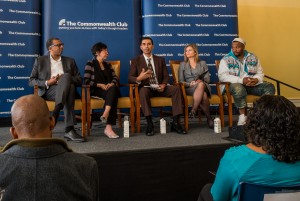US enviro groups under pressure to diversify ranks, leaders

Panelists at a session
SAN FRANCISCO — Mainstream US environmental groups are feeling the heat, and it’s more than climate change. In the green movement, there’s a growing sense of urgency to diversify – people of color are shut out to a staggering degree, and according
A study released last year by the Green 2.0 campaign found that people of color did not exceed 16 percent of the staff at any of the nearly 300 environmental organizations surveyed
Worse, Green 2.0 director Danielle Deane says that although foundations and NGOs “acknowledge that diversity is important to make a difference,” the survey
Deane spoke to a packed room
It was an effort by Green 2.0 initiative to bring key stakeholders together to institutionalize the means to diversify the leadership of the environmental movement and call on the field’s leaders to publicly acknowledge their commitment to diversity.
Release diversity data
And a key part of that acknowledgement is for more organizations to submit
“If you can’t measure it, you can’t manage it,” said investor, philanthropist and environmental advocate Tom Steyer. “This is measurable, and therefore to the extent that we have transparency and we have information, people can manage against that and see how they’re doing and give themselves goals.”
The Hewlett Foundation, one of the largest grant-making institutions for environmental organizations, signed on this week to share its diversity data, in what advocates said was an important signal that this is now a priority for the field.
Hewlett is joining other groups like the National Resources Defense Council, the Sierra Club, the National Audubon Society, and Earthjustice in an effort led by Green 2.0 (in collaboration with GuideStar and the D5 Coalition) to gather diversity data in order to create the transparency Steyer talks about.
“We are a much more successful society when we act together,” said Steyer. “You can show in the private
The Green 2.0 initiative is a project of The Raben Group, a government affairs and consulting firm that works in progressive policy-making and is headed by founder Robert Raben, a former Assistant Attorney General under the Clinton administration
Central challenge
“Diversifying the environmental movement is the central challenge of the movement and the central opportunity
“The question for us is, ‘Who makes decisions?’ People and communities that are most impacted by those decisions must not only lead on those issues, but they must be actively
The diversity challenge in the environmental movement can bring with it some internal conflicts, one example of which was relayed by Sierra Club executive director Michael Brune.
Late last year, after the ruling in the Eric Garner case in New York, the Sierra Club came out in support of the #BlackLivesMatter movement, making statements on social media and encouraging chapters to participate
While there was a significant positive response from many Sierra Club supporters and members, there was also an “embarrassing and hurtful” amount of backlash, much of it on social media, from supporters who opposed the organization’s involvement.
Learning opportunity
Brune took it as a “learning opportunity” about the work that has yet to be done, but it also strengthened his commitment to not only have a diverse organization, but also to participate
“As an organization, we can’t remain silent on core democratic issues, and as an environmental group, when we approach this from a justice perspective, that is what really enables
Brune added that the decision to diversify needs to come from an organization’s leadership, a statement echoed by Tomás Torres, director of the Environmental Protection Agency’s San Diego Border Office. “If it doesn’t come from the top, if the diversity initiative does not come from the leaders of your organizations, the initiative is not going to work,” Torres said.
And it’s more than just outwardly visible steps like implementing workshops and trainings. Internal processes, key among them hiring practices
Diversify hiring
Laura Butler, Pacific Gas & Electric’s chief diversity officer, pointed to the importance of slowing down the hiring process and recruiting from a larger pool, so companies aren’t just hiring people they already know. The latter can be the norm, she says, in company cultures that have “a need for speed.” Torres adds that hiring managers must be held accountable
Torres said further that organizations that don’t diversify do so at their peril: “I would venture to say that either demographics is going to take care of that issue eventually, or your organization will become irrelevant or obsolete.”
Tech entrepreneur Hank Williams, who founded the Platform Summit that focuses on diversity in innovation fields, compared Green 2.0’s efforts to collect diversity data to recent decisions by companies like Google to release theirs.
“Tech is beginning
“The green movement is a liberal-minded and philanthropic community, and if tech can do it, there is absolutely no reason that the green movement cannot at least get to the starting point, which is: Come out with your numbers
Like us on Facebook